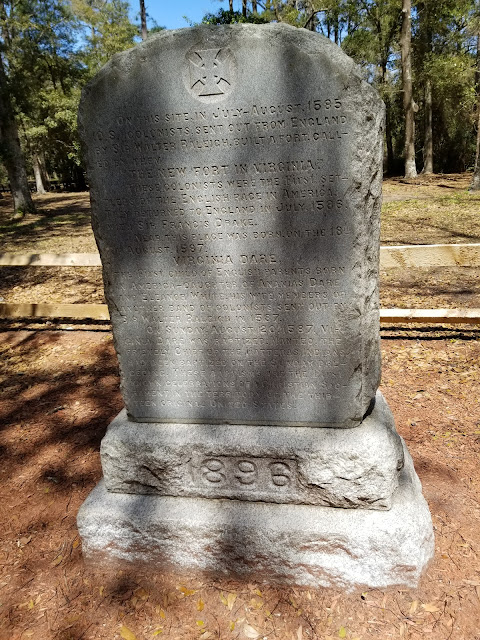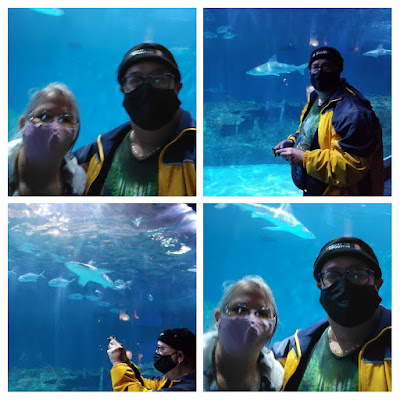Having never visited before, to us the Outer Banks had been a place we watched on the news as hurricanes moved toward it after they were finished threatening Florida. We found buildings here all eerily new looking, an obvious sign of rebuilding after storms, or "Hurricane community revitalization," as some would say. We found it to be quite interesting, and we were happy we visited when we did, free of the summer crowds, able to drive around and explore.
 |
| This marker marks the location where the Cape Hatteras Light Station was before it was moved due to erosion. |
 |
| 2900 feet from its original location the lighthouse is safe for awhile. |
We had a great time exploring the area surrounding the lighthouse and the surrounding area. We were unable to go to the top of this lighthouse, due to covid restrictions. We were however able to walk into some surrounding buildings. If you are interested, this is what the internet taught us about the lighthouse:
The Cape Hatteras Lighthouse protects one of the most hazardous sections of the Atlantic Coast. The current here forces southbound ships into a dangerous twelve-mile long sandbar called Diamond Shoals, giving it the reputation as the Graveyard of the Atlantic.
The first lighthouse was lit in October of 1803. Made of sandstone, it was 90 feet tall with a lamp powered by whale oil.
In 1853, following studies made by the Lighthouse Board, it was decided to add 60 feet to the height of the lighthouse, thereby, making the tower 150 feet tall.
By the 1860s, with the need for extensive repairs, Congress decided to appropriate funds for a new lighthouse, The new lighthouse was lit on December 16, 1870
In 1999, after years of study and debate, the Cape Hatteras Light Station was moved to its present location. The lighthouse was moved 2,900 feet in 23 days and now lies 1,500 feet from the seashore.
The "Lost Colony" of Roanoke Island
We were lucky to stay on Roanoke Island. Here we learned a little history about this spot. I'm sure it was part of our history lessons, but it wasn't very memorable. Having visited this spot, we learned about the Lost Colony of Roanoke Island. How in 1587, 117 English men, woman and children arrived in Roanoke Island. The ship that brought them to what is now Virginia returned to England and left the settlers behind to start the settlement. When a ship returned for them 3 years later, there were no survivors to be found, and no clues as to their location. Were they dead, or did they relocate. There were clues, but no answers. Fascinating. Was this not the first English settlement in America?
Per the web:
In 1587, 117 English men, women and children came ashore on Roanoke Island to establish a permanent English settlement in the New World. Just three years later in 1590, when English ships returned to bring supplies, they found the island deserted with no sign of the colonists. After nearly 450 years, the mystery of what happened to the colonists remains unsolved.
At almost every location we camped at our explorations brought us to something we never heard of but was so interesting, the lost colony of Roanoke was one of those. The theater usually has a drama playing in it describing what they believed happened to the colony, unfortunately for us it was closed due to covid.
Another surprise find was the North Carolina Aquarium on Roanoke Island, it was very close to our campground and we found it on an exploration of the area road trip. Sue and I love the ocean and this was of special interest to us.
The Currituck Beach Light is a lighthouse located on the Outer Banks in Corolla, North Carolina.
And now, the reason the Outer Banks was a must stop on this trip: The Wright Brothers National Memorial, located in Kill Devil Hills, North Carolina, commemorating the first successful, sustained, powered flights in a heavier-than-air machine. Our visit to this memorial was of importance to us as a follow up to our visit to the Carillon Historical Park in Dayton Ohio last year. We learned in Carillon of the Dayton native Wright Brothers many inventions and accomplishments, and we decided to put the location of the first flight at Kill Devil Hills on the Outer Banks on our must visit list. Its one of those history lessons you never forget, and we were glad to be able to follow up and visit this historic sight.












